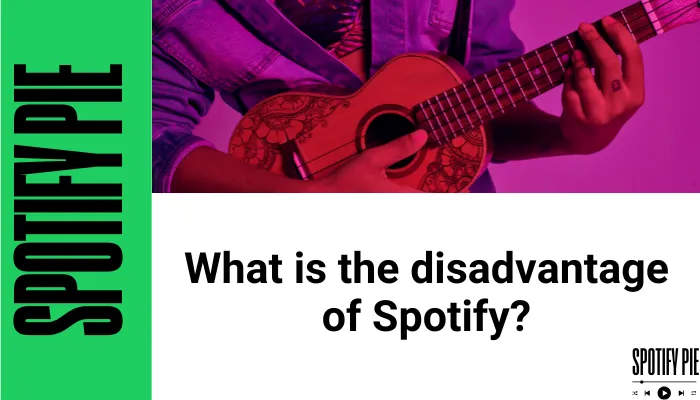What Is the Disadvantage of Spotify? Sound quality is one of the major downsides of using streaming services like Spotify. Songs are often compressed in order to ensure smooth playback on different internet connections.
This way, file size is reduced but audio fidelity may be compromised especially for discerning listeners.
Audiophiles will sorely miss the crystal clear highs and chest-thumping bass that come with uncompressed formats like FLAC or WAVs. For casual listeners though, they may not spot much difference specifically when listening through phone speakers or earbuds.

Sharing Some Pie Slivers Or Crumbs?
Artist compensation remains another bone of contention. Under Spotify’s complex royalty formulae; it boils down to streams made by an artiste. This is where things get heated:
- The Numbers Game: Critics are adamant that payouts per stream are ridiculous fractions of cents. It means unless an artiste gets millions in terms of streams, they will make insignificant amounts of money.
- The Industry’s Plight: Many musicians, especially those outside the mainstream, cannot survive on streaming alone. They therefore resort to live performances and merchandising which might be tough for upcoming acts.
However, whether streaming is a sustainable model for creators in the music industry remains to be seen.
A Global Playlist With Regional Restrictions
Spotify has not quite made its vast song library borderless despite the fact that music knows no boundaries. Licensing agreements may limit access to certain songs or artists in different regions. Users who frequently travel or have diverse musical preferences beyond their immediate areas may find this frustrating.
- The Licensing Labyrinth: The licensing rights differ by territory and sometimes artists or labels choose not to distribute their content in some regions. This means there are gaps in users’ listening experiences as some tracks will just bypass them.
- A World of Music, Unevenly Distributed: Certain regions are particularly poor when it comes to the availability of niche genres or less-known musicians. Consequently, for those loving fans who want something more than mainstream stuff, the experience of finding new music is hindered.
Personalization vs Privacy
Spotify makes personalized playlists and recommendations better than anyone else thanks to highly sophisticated algorithms that track your listening habits and curate content based on this. Nevertheless, there are concerns about privacy arising from overreliance on algorithms.
Spotify has a data collection problem. It collects much information about the user such as location, mood and even listening history However, while this data is necessary to make recommendations personalized, it raises questions about its storage, use, and sharing.
The filter bubble and beyond algorithmic suggestions create echo chambers where users are only exposed to music that matches their already existing tastes. This can curtail the exploration and uncovering of varied fresh music.
In a nutshell, Spotify’s position in streaming cannot be overrated. However, underneath the surface, there might be some potential pitfalls that should be considered.
Exploring Advantages and Disadvantages of Music Streaming
Music streaming has transformed music access and consumption.
No more bulky CD collections, no more entangled headphone wires; some taps on your phone screen are enough to bring all the music in the world at your fingertips.
However, is it all sunshine and roses in this industry? As with any technological advancement, there are pros and cons. Let’s dig deeper into this intricate ground.
An Irresistible Appeal of Streaming
- Unrivaled Selection: The number of songs available on streaming platforms are in millions and they cover almost every taste or genre possible (Cohen 2013). Those days when you could only have a few albums by your side are no more limitations that come with physical media.
- On-demand Listening: Do you want to hear one particular song? With streaming, just get it right away without having to scroll through playlists or skip across whole albums (Cohen 2013).
- Curated Playlists and Personalized Recommendations: These services utilize intelligent algorithms that generate playlists based on what people listen to. This personalization helps users discover new music that may be missed out otherwise.
- Affordability: In comparison to buying individual tracks or even albums, subscription-based music streaming offers a cost-effective way to access massive amounts of recorded sound. Most services provide free tiers with limited functionality as well as paid memberships allowing for ad-free streams plus a better audio quality among other things.
- Portability and Accessibility: Streaming platforms can be accessed from nearly anywhere with an internet connection. Carry your entire collection wherever you go – while traveling, being at home, sweating in the gym, or doing something else.
Potential Drawbacks
Amidst the undeniable convenience offered by music streaming, there exist some downsides that should be taken into account.
The Challenges of Platform Dependency
A good internet connection is required to stream music. It can be an obstacle for people in areas with poor internet infrastructure or low connectivity (Forbes 2015). Buffering and interruptions can ruin the joy of listening.
- Platform Stability: Such platforms depend heavily on their servers and infrastructure; otherwise, they will not work correctly. In case of outages and service interruptions, users might get angry as they won’t have access to music anymore.
- Long-Term Viability of the Streaming Model: Most streaming services are heavily supported by subscription payments. Some concerns have been raised regarding the long-term sustainability of this model particularly in relation to equitable remuneration for artists as well as smaller music labels.
- Potential Consequences of Platform Monopolization: Only a few major companies dominate music streaming. The centralization leads to suspicions about potential manipulation of prices, artist’s fees, and customer choices (Cohen 2013).
Social and Cultural Impact
These algorithms create echo chambers that suggest new songs based on old preferences. This limits exposure to new genres or artists thus hindering musical discovery (Forbes 2015).
Algorithmic curation could lead to cultural homogenization. Allowing everyone to listen to similar tunes depending on what they personally enjoy creates a risk that diversity and innovation in music can be stifled.
Listening through streaming appears to promote a more disposable attitude towards music. As such a vast store is always there for you, why would you invest your emotional bondings into particular albums or performers?
Solutions and Alternatives
Although there are difficulties associated with music streaming, it is possible to alleviate these disadvantages while enhancing user experience.
- Advocacy for Fairly Compensating Artists/Changing Industry Practices: – Attending live shows or buying merchandise directly from an artist can help support them financially. This includes advocating for improved royalty distribution through streaming platforms.
- Exploration Of Other Streaming Platforms And Models:- Some lesser-known independent streaming services provide better alternatives that give more attention to artists than others. Therefore, using those options may help create a richer musical ecosystem.
- Tips on Improving Your Streaming Experience as a User:- Musical discovery could be enhanced by making your playlists more diverse and going beyond what you normally listen to based on algorithms. In addition, one may want to explore independent musicians or labels as this offers exposure to different types of music at large-scale impact instead of restricted range comparison.
Conclusion
In conclusion, “What Is the Disadvantage of Spotify?” Spotify may have the best accessibility and convenience for its huge music library, but it falls short when it comes to artist earnings.
As a result of this system, payments to artists tend to be lower especially those who work alone as independent musicians, hence prompting discussions on a just remuneration.
However, despite its inadequacies, Spotify still stands out as the leading music streaming platform underscoring the importance for constant dialogue and possible change in order to ensure that artists are fairly paid.
